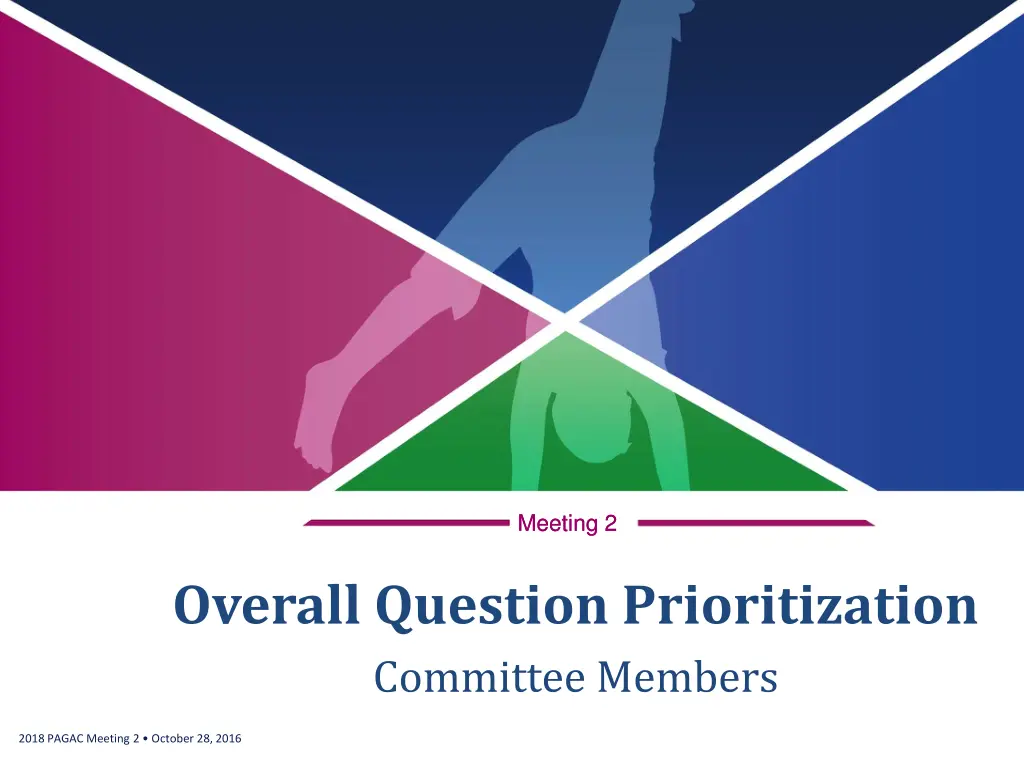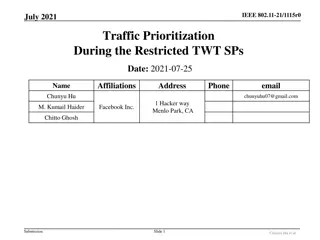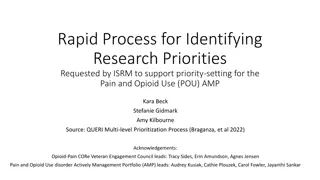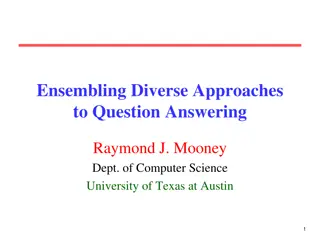
Health Prioritization Criteria and Subcommittee Questions - PAGAC Meeting Highlights
Explore the prioritization criteria and key questions discussed at the 2018 PAGAC Meeting, focusing on public health impact, policy relevance, and scientific evidence. Subcommittee questions delve into physical activity's effects on physical function, brain health, and cancer prevention.
Download Presentation

Please find below an Image/Link to download the presentation.
The content on the website is provided AS IS for your information and personal use only. It may not be sold, licensed, or shared on other websites without obtaining consent from the author. If you encounter any issues during the download, it is possible that the publisher has removed the file from their server.
You are allowed to download the files provided on this website for personal or commercial use, subject to the condition that they are used lawfully. All files are the property of their respective owners.
The content on the website is provided AS IS for your information and personal use only. It may not be sold, licensed, or shared on other websites without obtaining consent from the author.
E N D
Presentation Transcript
Meeting 2 Meeting 2 Overall Question Prioritization Committee Members 2018 PAGAC Meeting 2 October 28, 2016
Overarching Criteria for Question Prioritization Potential for greatest public health impact Potential to inform public health policy and/or programs Existence of mature scientific evidence Potential generalizability to the population of interest 2 2018 PAGAC Meeting 2 October 28, 2016
Principles for Question Prioritization Does the scientific evidence inform the Guidelines about selection of a target dose? The type, volume, intensity, or other characteristics of the target dose. The value or reasonableness of selecting a target dose. Does the scientific evidence inform the Guidelines with new or supportive information regarding the health impact of physical activity? Strength of the scientific support. New health benefits (e.g., reduced risk of dementia) or risks of PA. Confirm previous benefits or risks of PA for which scientific support had been moderate. [Note: Reconfirmation of previously well-established health benefits is less informative.] 3 2018 PAGAC Meeting 2 October 28, 2016
Principles for Question Prioritization Does the scientific evidence inform the Guidelines from a public health perspective? The general population. If a subpopulation, how large a population. If a subpopulation, how new is the information. If a subpopulation, is it an underserved population. Does the scientific evidence inform the Guidelines about encouraging and facilitating physical activity? Environments that facilitate PA. Types of interventions that encourage PA. How confident are we that the scientific evidence will accomplish one or more of the above objectives? 4 2018 PAGAC Meeting 2 October 28, 2016
Questions in Process Each Subcommittee has its first priority question in process 5 2018 PAGAC Meeting 2 October 28, 2016
Subcommittee 2nd Questions Number 2 Priority Questions What is the relationship between physical activity and physical function? a. What is the nature of the dose-response relationship? b. What type(s) of physical activity are effective for improving or maintaining physical function; c. What factors modify the relation between physical activity and physical function? Aging Q2 What is the relationship between physical activity and emergent properties of brain function? a. Well-being: Is there a relationship between physical activity and perceptions of well-being and quality-of-life in healthy and impaired populations? Brain Health Q2 Cancer- Primary Prevention Q2 What is the association between sedentary behavior and invasive cancer incidence? 6 2018 PAGAC Meeting 2 October 28, 2016
Subcommittee 2nd Questions Number 2 Priority Questions Is there a relationship between physical activity and blood glucose control (incidence of impaired glucose tolerance or type 2 diabetes mellitus) in adults without diabetes? a. Is there a significant relationship? b. Is there a dose-response relationship? If yes, what is the shape of the relationship? c. Does the relationship vary based on levels of sedentary, light, moderate or vigorous physical activity? d. Is this relationship independent of weight status? e. Does the relationship vary by age, ethnicity or socio-economic status? Cardiometabolic Health and Weight Mgmt Q2 What is the relation between physical activity and cardiovascular disease mortality? Exposure Q2 7 2018 PAGAC Meeting 2 October 28, 2016
Subcommittee 2nd Questions Number 2 Priority Questions In people with neuro-motor disease, what is the relationship between physical activity and (a) risk of cardiovascular disease; (b) physical function; and (c) risk of comorbid conditions? Individuals with Chronic Conditions Q2 When physical activity is related to an outcome, additional questions are: 2a. Is there a dose-response relationship and if so, what is its shape? 2b. Does the strength of the relationship depend upon: frequency, duration, intensity, type (mode), how physical activity is measured, and/or characteristics of people (e.g. age, gender)? Promotion of Physical Activity Q2 What are effective interventions for reducing sedentary behavior? 8 2018 PAGAC Meeting 2 October 28, 2016
Subcommittee 2nd Questions Number 2 Priority Questions What is the relationship between sedentary behavior and mortality from cardiovascular disease? a. Is there a significant relationship? b. Is there a dose-response relationship? If yes, what is the shape of the relationship? c. Does the relationship vary by age, sex, ethnicity or socio- economic status? d. Is the relationship independent of levels of light, moderate or vigorous physical activity? e. Is there any evidence that bouts or breaks in sedentary behavior are important factors? Sedentary Behavior Q2 9 2018 PAGAC Meeting 2 October 28, 2016
Subcommittee 2nd Questions Number 2 Priority Questions Recent evidence for the effects of moderate-to-vigorous physical activity, vigorous physical activity, and total physical activity of selected types, on health outcomes in youth a. Is physical activity related to cardiorespiratory fitness, weight status, and other cardiometabolic risk factors? b. Does physical activity prevent or reduce excessive weight gain that results in overweight or obesity? c. Are muscle-strengthening and bone-strengthening physical activity related to musculoskeletal health? d. Does recent evidence inform dose-response curves for established associations? Youth Q2 10 2018 PAGAC Meeting 2 October 28, 2016
Question Prioritization - QHM QHM (high medium) What is the relationship between physical activity and emergent properties of brain function? a. Affect: Is there a relationship between physical activity and affect and does such a relationship exist across a continuum of mood and affective disorders (i.e., depression)? Is there a relationship between physical activity and weight control during pregnancy and postpartum in adults? a. Is there a significant relationship? b. Is there a dose-response relationship? If yes, what is the shape of the relationship? c. Does the relationship vary based on levels of sedentary, light, moderate or vigorous physical activity? d. Does the relationship vary by age, ethnicity or socio-economic status? Brain Health Q3/6 Cardiometabolic Health and Weight Mgmt Q3/8 What is the relation between bout duration of continuous aerobic physical activity and cardiorespiratory fitness OR health outcomes? Exposure Q5/8 11 2018 PAGAC Meeting 2 October 28, 2016
Question Prioritization - QHM QHM (high medium) What is the relationship between sedentary behavior and incidence of diabetes, obesity, cardiovascular disease and cancer? a. Is there a significant relationship? b. Is there a dose-response relationship? If yes, what is the shape of the relationship? c. Does the relationship vary by age, sex, ethnicity or socio-economic status? d. Is the relationship independent of levels of light, moderate or vigorous physical activity? e. Is there any evidence that bouts or breaks in sedentary behavior are important factors Sedentary Behavior Q4/5 Sedentary behavior and health in youth a. Is sedentary behavior associated with health outcomes, including weight status/body composition, in youth? b. Are the effects of sedentary behavior on health outcomes in youth independent of the effects of light, moderate, or vigorous physical activity on those outcomes? Youth Q3/3 12 2018 PAGAC Meeting 2 October 28, 2016
Question Prioritization - QLL QLL (low low) Is there a relationship between physical activity and inflammatory markers in adults? a. Is there a significant relationship? b. Is there a dose-response relationship? If yes, what is the shape of the relationship? c. Does the relationship vary based on levels of sedentary, light, moderate or vigorous physical activity? d. Is this relationship independent of weight status? e. Does the relationship vary by age, ethnicity or socio-economic status? Is there evidence that physical activity adds to the magnitude of weight loss achieved with caloric restriction in adults? a. Is there a significant relationship? b. Is there a dose-response relationship? If yes, what is the shape of the relationship? c. Does the relationship vary based on levels of sedentary, light, moderate or vigorous physical activity? d. Does the relationship vary by age, sex, ethnicity or socio-economic status? Is cardiorespiratory fitness a modifiable mediator of the benefits of physical activity? Should it be treated as an outcome? Cardio-metabolic Health and Weight Mgmt Q7/8 Cardio-metabolic Health and Weight Mgmt Q8/8 Exposure Q8/8 13 2018 PAGAC Meeting 2 October 28, 2016
Question Prioritization - QMM QMM (medium medium) What is the relationship between physical activity and risk of frailty? a. What is the nature of the dose-response relationship? b. What type(s) of physical activity are effective for preventing or delaying frailty? c. What factors modify the relation between physical activity and risk of frailty? What is the relationship between physical activity and emergent properties of brain function? a. Anxiety: Is there a relationship between physical activity and anxiety and does such a relationship exist across the continuum of anxiety disorders? What is the relationship between physical activity and emergent properties of brain function? a. Sleep: Is there a relationship between physical activity and sleep and circadian rhythms that include normal to impaired sleep behaviors? Aging Q3/3 Brain Health Q4/6 Brain Health Q5/6 What is the relationship between physical activity and biomarkers of brain health? Brain Health Q6/6 14 2018 PAGAC Meeting 2 October 28, 2016
Question Prioritization - QMM QMM (medium medium) Is there a relationship between physical activity and metabolic syndrome, and the components of metabolic syndrome (blood pressure, lipids, abdominal adiposity) in adults? a. Is there a significant relationship? b. Is there a dose-response relationship? If yes, what is the shape of the relationship? c. Does the relationship vary based on levels of sedentary, light, moderate or vigorous physical activity? d. Is this relationship independent of weight status? e. Does the relationship vary by age, ethnicity or socio-economic status? Does physical activity alter body composition (lean tissue, fat tissue, intramuscular fat) with weight loss in adults? a. Is there a significant relationship? b. Is there a dose-response relationship? If yes, what is the shape of the relationship? c. Does the relationship vary based on levels of sedentary, light, moderate or vigorous physical activity? d. Does the relationship vary by age, sex, ethnicity or socio-economic status? Cardio-metabolic Health and Weight Mgmt Q4/8 Cardio-metabolic Health and Weight Mgmt Q5/8 15 2018 PAGAC Meeting 2 October 28, 2016
Question Prioritization - QMM QMM (medium medium) Is there a relationship between physical activity and weight change following clinically meaningful weight loss of at least 5% in adults? a. Is there a significant relationship? b. Is there a dose-response relationship? If yes, what is the shape of the relationship? c. Does the relationship vary based on levels of sedentary, light, moderate or vigorous physical activity? d. Does the relationship vary by age, sex, ethnicity or socio-economic status? Cardio-metabolic Health and Weight Mgmt Q6/8 What is the relation between physical activity and cardiovascular disease incidence? Exposure Q3/8 What is the relation between step count per day and mortality (all-cause or cause-specific) or disease incidence (e.g., coronary heart disease, type 2 diabetes)? Exposure Q4/8 What is the relation between high intensity interval training and reduction in cardiometabolic risk? Exposure Q6/8 16 2018 PAGAC Meeting 2 October 28, 2016
Question Prioritization - QMM QMM (medium medium) How does the declining basal level of activity influence the volume of physical activity (presumably MVPA) required to maintain a similar level of energy expenditure per day? Exposure Q7/8 In people with osteoarthritis, what is the relationship between physical activity and (1) progression of osteoarthritis and (2) risk of co-morbid conditions, and (3) physical function? Individuals with Chronic Conditions Q3/4 When physical activity is related to an outcome, additional questions are: 3a. Is there a dose-response relationship and if so, what is its shape? 3b. Does the strength of the relationship depend upon: frequency, duration, intensity, type (mode), how physical activity is measured, and/or characteristics of people (e.g. age, gender)? 17 2018 PAGAC Meeting 2 October 28, 2016
Question Prioritization - QMM QMM (medium medium) For the following chronic conditions, can the relationship between physical activity and (1) disease progression, (2) risk of co-morbid conditions, (3) physical function and (4) measures of quality of life be ascertained from existing systematic reviews of the literature? 1) Peripheral artery disease 2) Chronic renal disease 3) Type 2 Diabetes 4) Cancer survivors 5) Hypertension 6) Lipid disorders 7) Obesity 8) HIV/AIDS 9) Osteoporosis 10) Rheumatoid arthritis 11) Low back pain 12) Intellectual disability including Downs Syndrome 13) Epilepsy 14) Mixed connective tissue disease (e.g. systemic lupus erythematosus). 15) Traumatic brain injury Individuals with Chronic Conditions Q4/4 When one or more systematic reviews of sufficient quality exist, and when the review(s) concludes physical activity is related to an outcome: 4a. Is there a dose-response relationship and if so, what is its shape? 4b. Does the strength of the relationship depend upon: frequency, duration, intensity, type (mode), how physical activity is measured, and/or characteristics of people (e.g. age, gender)? 18 2018 PAGAC Meeting 2 October 28, 2016
Question Prioritization - QMM QMM (medium medium) What is the relationship between sedentary behavior and incidence of diabetes, obesity, cardiovascular disease and cancer? a. Is there a significant relationship? b. Is there a dose-response relationship? If yes, what is the shape of the relationship? c. Does the relationship vary by age, sex, ethnicity or socio-economic status? d. Is the relationship independent of levels of light, moderate or vigorous physical activity? e. Is there any evidence that bouts or breaks in sedentary behavior are important factors Sedentary Behavior Q4/5 19 2018 PAGAC Meeting 2 October 28, 2016
Meeting 2 Meeting 2 Committee Discussion Committee Discussion 2018 PAGAC Meeting 2 October 28, 2016
Meeting 2 Meeting 2 Wrap Up and Next Steps Wrap Up and Next Steps Abby King, PhD and Ken Powell, MD, MPH Co-Chairs, 2018 Physical Activity Guidelines Advisory Committee 2018 PAGAC Meeting 2 October 28, 2016
Meeting 2 Meeting Adjourned Meeting Adjourned Richard D. Olson, MD, MPH Designated Federal Officer






















